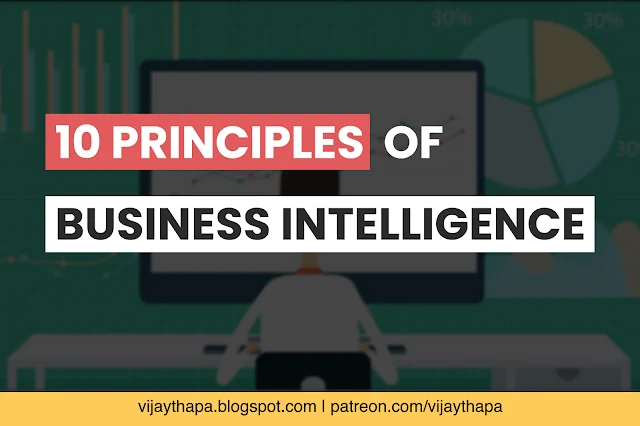 |
| 10 Principles of Business Intelligence |
Hello Everyone, I'm Vijay Thapa,
Freelance Software Developer.
And from this slide, I want to talk
a little about Business Intelligence
and its 10 Principles according to
Thomas H. Davenport (President’s Distinguished Professor in Management and
Information Technology at Babson College).
Before diving directly into the 10
principles, what is this BI (Business Intelligence)?
Based on my understanding, BI is a
tool to process and analyze huge amount of data and present it into simple and
actionable information that can help Managers & Executives in Decision Making.
As you can see in Slide 4, first huge amount of data is
collected from different sources like databases, texts, etc. and then they are
stored in a single database (also called data-warehouse), then using different
BI tools and algorithms, these data are processed to get valuable information
in graphical form (like charts and bar graphs) which is helpful to make
fruitful decisions in any organizations. Here, BI data can have both Historical
Data (Data that’s been collected over a period of time) or newly generated
data.
The term Business Intelligence (BI)
was first used in the 1860s, but consultant Howard Dresner is credited with first proposing it in 1989 and
implementing it on Decision Making Systems.
Now, let’s talk about the
Principles of BI. Here, on the basis of what I’ve understood so far, I’ve
grouped these 10 principles of BI into 2 categories. They are as follows
a.
BI + Human
Structured Decision = Better Decision
b.
Be
Specific/Selective
Before discussion about these two
in detail, I’d like to talk a little about Decision
Making and Some of its types.
Every day, from having a breakfast
to buying anything, we’ve to make some decision and pick one from different
options available.
Thus, Decision Making can be
described as the mental state that leads to the selection of an action among
various alternatives available and produces a final choice. And the output can
be either an action or an opinion.
Some of the different types of
Decisions are discussed below
a.
Loosely
Coupled Decision
It is a type of
decision, where the final decision is made from limited set of data or
knowledge.
For example, when we visit Chinese restaurant for the
very first time, we make our first order based on the image provided on the
menu, ingredients used and the name of the food. Here, we do not have the
sufficient data of how many people ate that food? Or How many liked/Disliked
that food? etc.
Thus, the decision
made to order the food was Loosely Coupled. And the decision might be very
accurate in this type.
b.
Structured
Human Decision
Here the decisions are still made by human professionals,
but “specific efforts have been made to improve decision making processes or contexts by determining the
specific information and other process resources needed to make better
decisions faster”.
c.
Automated
Decision
Here, the decision
is made using different BI tools along with different rules and Algorithms. The main objective is to
make the process fully automated and therefore very efficient. This only works
with decisions that are well structured and reducible to a set of rules.
Traditional BI uses Loosely Coupled
Decision, whereas Modern BI uses
Automated Decision.
Now, let’s discuss about the 10
Principles of BI
A.
BI + Human
Decision = Better Decision
As discussed
earlier, Modern BI uses Automated Decision using different algorithms which can
make much accurate decisions but if combined with Structured Human Decision,
Better Decision can be made.
Thus, some of the
major principles of BI that falls under this category are as follows
1.
Decisions are the unit of work to which BI initiatives should be
applied.
2.
Providing access to data and tools isn’t enough
if you want to ensure that decisions are actually improved.
3.
“Loosely coupled” decision and information
relationships are efficient to provision with information (hence many decisions
can be supported), but don’t often lead to better decisions.
4.
The most interesting relationship involves
“structured human” decisions, in which human beings still make the final
decision, but the specific information used to make the decision is made
available to the decision-maker in some enhanced fashion.
5.
You can’t really determine the value of BI or
data warehousing unless they’re linked to a particular initiative to improve
decision-making. Otherwise, you’ll have no idea how the information and tools
are being used.
B.
Be
Specific/Selective
As we know, BI
data includes huge amount of data to process and present useful information
that can help in Decision Making. But this huge amount of data may not be
useful for every case.
For example, To recognize the different types or stages
of cancer, the data of heart patient might not be useful.
Thus, the specific
data can provide better and accurate data.
Now, some of the
remaining Principles of BI that falls on this category are listed below
1. If you’re
going to supply data to a decision-maker, it should be only what is needed
to make the decision.
2. The
relationship between information and decisions is a choice organization can
make–from “loosely coupled,” which is what happens in traditional BI, to
“automated,” in which the decision is made through automation
3. The more
closely you want to link information and decisions, the more specific you have
to get in focusing on a particular decision.
4. Efforts to
create “one version of the truth” are useful in creating better decisions, but
you can spend a lot of time and money on that goal for uncertain return unless
you are very focused on the decisions to be made as a result.
5. Business
intelligence results will increasingly be achieved by IT solutions that are
specific to particular industries and decisions within them.
Click to Download this Slide









![Advertisement [ad]](https://blogger.googleusercontent.com/img/a/AVvXsEgVAiCox6-vLXsNZas8ks-nfos0PgdnL4yClmlqOkl92t7zGdYYiLBy9AHMZFxBYe06DVmN6JGQ9S0P3iClXk8l43FIQPDyAcx_uMmV0bN9JlKjTzOAi7YjmQo6cuvHgkEO76L-hcqV-TWE29v93eeFby8MOAOuJ8DcilHTPpfP8aKg8TG9uYCDaMxcr8H1=s600)


Comments